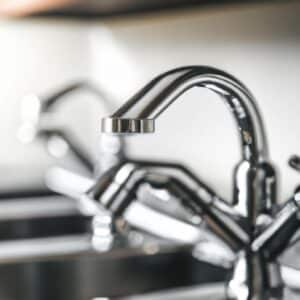Cleaning kitchen tile grout can be a daunting task, but it doesn’t have to be! Keeping your kitchen tile grout clean is an important part of home maintenance, and it can help prevent the buildup of mold, mildew, and bacteria. With the right supplies and a few simple tips, you can restore your tile floors to their former spotless state. In this article, we’ll discuss the basics of grout, different types of grout, and effective methods for cleaning kitchen tile grout. We’ll also go over how to distinguish different types of grout and tackle stubborn stains with a steam cleaner, grout brush, and more. So, let’s get started!
Basic Cleaning Supplies
Keeping kitchen tile grout clean requires the right materials. To get started, you’ll need warm water, a spray bottle, white vinegar, and hydrogen peroxide. You may also want to have a grout brush, a steam cleaner, and some other cleaning supplies on hand, depending on the job.
Warm water and a spray bottle are a great place to start. This combination can be used to help get rid of light dirt and debris on the grout. If you have slightly more stubborn stains, white vinegar and hydrogen peroxide can be used in a solution to help tackle them. Using a grout brush and steam cleaner can help to remove the toughest of stains. To distinguish the different types of grout, the steam cleaner can be used to heat the grout to reveal its composition. With the right tools and techniques, you can restore your kitchen tile grout to a spotless state.
Cleaning Grout Lines
Cleaning the grout lines of your kitchen tiles is a daunting task. Even with the right tools, it can be difficult to reach into those hard-to-reach areas and remove stubborn stains. Fortunately, with the right tips and tricks, you can restore your tiles to a spotless state.
Using a grout brush and steam cleaner are key when it comes to cleaning grout lines. For hard-to-remove stains, a steam cleaner can provide a deep clean that won’t damage your kitchen tiles. When using a steam cleaner, it’s important to distinguish between different types of grout: cement-based grout requires a lower steam temperature than epoxy-based grout, for example. You can also clean grout lines with a combination of hydrogen peroxide, baking soda, and water for creating a cleaning solution with a potent scrubbing power. Alternatively, you can try cleaning stubborn grout lines with just plain water and hot water. Steam mops and microfiber cloths also provide a good way to remove dirt and grime without damaging your tiles.
Once you have thoroughly cleaned your grout lines, wipe down the tiles with clean water and dry them with a microfiber cloth. With the right tools and tips, you can restore your tiles to a spotless state and enjoy a clean and beautiful kitchen.
Making a Cleaning Solution
For those tougher stains, try a homemade grout cleaning solution. It’s easy to make and can be used to tackle even the most stubborn grout problems. To make your solution, combine one cup of hydrogen peroxide with one cup of baking soda in a bowl. Stir the mixture until it forms a paste. Apply the paste directly to the grout lines. Let it sit for 15 minutes, then use a grout brush to scrub away any remaining dirt and residue. Rinse the area with warm water. Alternatively, use a combination of plain water and hot water to scrub away at the grime. For an even deeper clean, try a steam mop or microfiber cloth. Before you start, make sure to test your cleaning solution in an inconspicuous area to make sure it won’t damage your tiles or grout. After you’ve thoroughly scrubbed the grout lines, wipe them down with a damp cloth to remove any leftover residue. Finally, dry the tiles with a microfiber cloth and admire the spotless state of your kitchen tile grout!
Alternatives to a Cleaning Solution
If the simplicity of using a cleaning solution isn’t for you, there are alternative methods for restoring your tile floors to a spotless state. For example, you can use plain or hot water to clean the grout lines. This is a simple, yet effective method for cleaning grout and should be your first go-to. If the grout is particularly stubborn, however, you can try using a steam mop. This uses a combination of pressure and hot steam to loosen up grime and dirt that would otherwise be difficult to remove. Microfiber cloths are also an excellent choice for grout cleaning, as they can pick up a lot of dirt and grime without much effort.
No matter which option you choose, make sure to finish up by wiping down the tiles with clean water and then drying them with a microfiber cloth. With these tips and tricks, you’ll soon be able to restore your tile floors to a spotless state.
Final Steps
It’s time to finish up your grout-cleaning project! You’ll be amazed at the transformation your kitchen tiles make once you’ve finished. To wrap up your grout-cleaning project, here’s what to do:
Start by wiping down the tiles with clean water. Remove any residue that the cleaning solution left behind. Then, dry the tiles with a microfiber cloth. This will help prevent mildew or mold from forming.
Once the tiles are cleaned and dried, you’ll be able to admire your handiwork. With the right tools and methods, you can restore your kitchen tile grout to a spotless state. Enjoy your newly refreshed tile floors and bask in the knowledge that you can take on even the toughest grout cleaning jobs.





